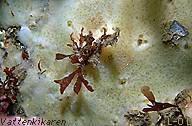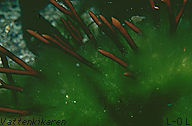 |
|
Competition
If several organisms try to exploit the same
resource although it is too small, a competitive situation arises. Competition
can arise between several individuals of the same species, or between individuals
of different specie.
Periwinkles
grazing on cliffs and rocks can for example start competing for food
when they became too many and the food source cannot reproduce itself in
a quick enough tempo to replace those that have been eaten. In such a situation
they can stop growing, even lose weight and die. If two specie compete for
the same food source, for example the common
periwinkle and the rough
periwinkle, competition can be a possible reason for why one species
is more common than the other within a certain area. This might be the result
of a more effective exploitation of food resources, or that one species
prevents the other from fully utilizing the resources.
Amongst cliffs and rocks, competition can easily arise because
a great many creatures want to utilize the substrate to attach to or to
look for food. Many types of algae also need to be attached so they are
able to utlilize the sunlight.
 |
|
 |
| In the left-hand picture, a bead
crumb sponge is seen dominating the bottom. Only a few older
red algae are able get any room. New organisms probably have difficulty
establishing themselves in this area. In the right-hand picture,
a fast growing thread-like algae is seen growing over furcellaria
lumbricalis. The red algae runs the risk of getting too
little light. |
 |
Page 42 of
52 |
 |
|


